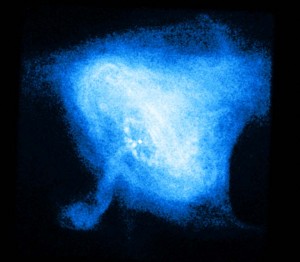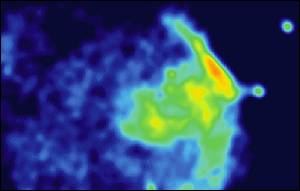Credit: NASA/CXC/MSFC/M.Weisskopf et al & A.Hobart
Click below to view video
watch?v=E2DR8rBKM4M
In a recent comment, gmagee inquired about the rings of X-ray emission that are seen to be expanding away from the Crab pulsar and whether this activity might be more likely interpreted as being intrinsic to the pulsar wind rather than to an impacting galactic cosmic ray volley. This ring motion was reported in the news today, one story appearing in PhysOrg (http://www.physorg.com/news/2011-05-crab-nebula-action-case-dog.html).
In answer to this question, I would respond, no. The expanding ring of emission is most likely produced by the superwave, not by the Crab pulsar. Much of the misconception on interpreting this phenomenon concerns the all too common belief that the Crab pulsar lies near the geometrical center of the Crab Nebula. This misconception is perpetuated not only in technical papers but in media news reports such as the above cited report. To the contrary, as I had proposed in chapter 5 of my 1983 Ph.D. dissertation (see in particular pp. 179 – 180 of the dissertation update), a careful analysis of the kinematics of the Crab pulsar and of the high velocity filaments traveling outward from the explosion center shows that the Crab pulsar is most likely situated at the forefront of the Nebula (4 – 5 light years from the center) and is traveling almost directly towards us at ~1500 km/s (2° angle deviation from our line of sight). Only when viewed in projection from our vantage point does it “appear” to lie at the geometrical center of the Nebula. I would rather not go into the details of this explanation here since it is rather extensive, but refer readers to my dissertation. Also the peripheral nebular placement of the Crab pulsar is to a much less extent dealt with on page 74 of Decoding the Message of the Pulsars. Other reasons why the pulsar is not the source of the cosmic rays energizing the Crab Nebula are given in my dissertation, in my 1987 Earth, Moon, and Planets paper, and in chapter 10 of my book Earth Under Fire.
This high velocity scenario I am proposing suggests either that 1) the Crab supernova explosion was asymmetrical in such a manner as to eject its central neutron star outward in our direction, or 2) that the Crab neutron star progenitor was part of a close binary and that its partner star destroyed itself in the explosion and simultaneously ejected and propelled its neutron star partner outward along the pulsar’s current trajectory. Examples of such hyperfast pulsars are PSR B1508+55 and B1757-24. An example of B1757-24 is shown in the image below. If this were the Crab pulsar, we would be far off to the right viewing the pulsar and its nebula face on.
As I pointed out 28 years ago in my dissertation, an impacting superwave would create a bow shock region around the Crab pulsar. Hence waves of superwave cosmic rays hitting this shock region, travelling way from us into the plane of the sky at the Crab location, would give the appearance to us of concentric rings of X-ray emission expanding away from the Crab pulsar as they proceded in the anticenter direction to the rear of the pulsar. The shock front generating these moving X-ray rings (in the vicinity of the Nebula’s luminous wisps) may not necessarily correspond with the shock region that I have suggested is responsible for producing the gamma ray synchrotron emission flares. There may be several such emission nodes in the supernova shell that would be emitting high energy radiation. But they may not necessarily all be at the same distance relative to a given cosmic ray front in the superwave. So although the Crab pulsar X-ray rings and the gamma ray flares are both being energized by superwave cosmic rays, they would not necessarily be impacted simultaneously by a given front. This would explain why no correlative results are seen for the two emission phenomena.
[I would like to point out here that in giving the above explanation I am not constructing a model a posteriori to fit the data. My model was proposed 28 years ago and I see no reason to change it. I am simply explaining how this apriori proposed model would produce the observed results. In short, findings which astronomers say seem very mysterious, are seen not really to be that mysterious after all.]



Here is an example of a massive fast-moving star, named Zeta Ophiuchi, ejected from a supernova blast. A bow shock accompanies the star.
http://www.physorg.com/news/2011-01-runaway-star-plows-space.html
Researchers now acknowledge that the center of the energy emission is offset slightly from the pulsar. They formulate a energy displacement and wind theory to explain this phenomenon.
http://www.physorg.com/news/2012-02-high-energy-emissions-crab-nebula.html
I answer your comment here:
http://starburstfound.org/superwaveblog/?p=238